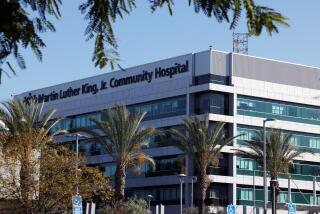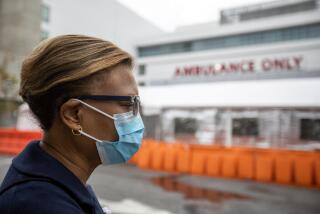Pressed in Case of Emergency
- Share via
It was just 9 a.m., and already patients filled the 22 emergency room beds at Downey Regional Medical Center and spilled over into chairs in the hallway.
Chief nurse Andrew Greene managed the mayhem with the practiced calm of a Buddha in blue scrubs.
This recent weekday, after all, was only slightly busier than usual: The emergency room typically is full by noon. It stays full until midnight.
“We’ve had a lot of abdominal pains, chest pains, falls, hip injuries,” Greene said, checking his clipboard. Patients ranging from 11 months to 80 years had broken arms, pneumonia and enough upper respiratory infections to spark fears among staffers of an early flu season.
For an emergency room network as stressed as Los Angeles County’s, it’s a scary thought.
The network of 75 public and private hospitals is still reeling from last month’s announcement that Centinela Freeman HealthSystem will close the emergency room at its Memorial campus in Inglewood in December, becoming the 10th hospital in Los Angeles County to do so in five years.
Now Downey and other nearby hospitals are watching with growing anxiety as the county tries to stave off a loss of federal funding that could doom its long-troubled Martin Luther King Jr./Drew Medical Center in Willowbrook, just south of Watts.
King/Drew’s emergency room treated more than 47,000 patients last year. Memorial, formerly known as Daniel Freeman Memorial Hospital, treated about 38,000. If both were to close, “85,000 patients -- 235 patients a day -- would have to go someplace else,” said Carol Meyer, director of the county’s emergency medical services. “The ripple effect would be profound.”
King/Drew serves a densely populated area that includes South Los Angeles, Compton and Lynwood.
Two of the nine private hospital emergency rooms that have already closed were nearby.
Healthcare professionals and residents worry that the heavily minority and impoverished neighborhoods will be left without the medical care they need. Only the more sparsely populated Antelope Valley in the county’s far north has as few hospitals.
Losing emergency rooms outside the South Los Angeles region hurt the network overall but didn’t have a major effect in the immediate area, Meyer said.
“If you drew a five-mile radius around those hospitals, there were multiple other choices,” she said. “You don’t have that in the South-Central L.A. area. And five miles is a long way in such an urban area.”
The only hospital within five miles of Memorial is its sister institution, Centinela, also in Inglewood, where emergency services and some other departments will be consolidated. Only one hospital -- Lynwood’s St. Francis Medical Center -- is within five miles of King/Drew.
Residents of these neighborhoods want to know they have a reliable source of care. Gary Fuller, 48, lives just across the 105 Freeway from King/Drew, and he and other family members have used the emergency room there several times over the years. Last week, his best friend was in the hospital after suffering a stroke and being admitted through the emergency room.
“If they hadn’t gotten him here in time,” said Fuller, “he would have died.”
The county’s last-ditch plan to save King/Drew would keep the hospital’s heavily used emergency room open. By eliminating or transferring other services and turning over management to Harbor-UCLA Medical Center, the county is hoping to persuade a federal agency to reconsider pulling the plug on funding.
But the still-evolving plan would reduce inpatient beds from about 252 to 42, at least initially, and that in turn would limit the emergency care King/Drew could deliver.
“With only 42 beds,” said Downey’s chief operating officer, Robert Fuller, “they will be full in three hours.”
Overflowing waiting rooms are the most visible but not the only reason emergency rooms get backlogged. If no inpatient beds are free, emergency patients who need hospitalization continue taking up ER beds, and ambulance paramedics wait longer to hand off new patients.
“If you increase the time paramedics spend on hospital parking lots,” Fuller said, “that would have an impact on the whole L.A. Basin. Ambulance response times are going to go up, and some poor lady in Beverly Hills having a heart attack is going to have to wait longer.”
When crowding is most extreme, hospitals go on “diversion” and turn ambulances away, making them go farther.
Some hospitals are on diversion most of the time. Last year, public hospitals, including County-USC and Harbor, were closed to ambulances an average of about 20 hours a day. Some private hospitals, including St. Francis, the one closest to King/Drew, were closed for 12 hours or more.
“We know that St. Francis operates pretty much at capacity now,” said Jim Lott, executive vice president of the Hospital Assn. of Southern California.
The next nearest hospitals to King/Drew is Memorial Hospital of Gardena, 6 1/2 miles away, and Downey, about seven miles. But the ripple effects could extend farther than that.
‘Big Problems’
About 75% of King/Drew’s in-patients are admitted through its emergency room, a higher proportion than at most hospitals.
Many of its patients lack health insurance and don’t get regular care for such chronic conditions as diabetes and heart disease. By the time they seek help at an emergency room, they frequently require hospitalization.
“We hope that the plan ... can keep that emergency room open,” said Meyer, the county’s emergency medical services director. “But no matter what, fewer beds -- when the majority of patients need admission -- mean there is going to be wait time in that emergency room, and people are going to go elsewhere.”
At King/Drew, as at most emergency rooms, more people arrive by car or bus than by ambulance. Even if a hospital goes on diversion, the staff is still obligated to see these walk-in patients. But if the wait is too long, they move on their own to the nearest alternative.
Gardena’s Memorial Hospital sees about 2,400 emergency room patients a month. Chief Executive Steve Popkin said that, although it would be a stretch, the emergency room could probably absorb 400 more patients a month.
“Beyond that,” he said, “we would have big problems.”
Popkin acknowledged that his concern was as much financial as operational. Federal law requires that hospitals with emergency rooms screen and stabilize all who seek care, regardless of their ability to pay.
“When you add in King/Drew, it would disproportionately raise our number of uninsured,” he said.
A study conducted last year for the Hospital Assn. of Southern California found that the number of uninsured patients visiting private emergency rooms in Los Angeles County had increased by a third since 2000. That’s roughly the same period during which the nine private hospitals closed or shut down their emergency rooms.
Along with virtually every other health organization in California, the association is supporting Proposition 86 on the Nov. 7 ballot, which would increase the state’s tax on cigarettes to raise money for hospital emergency services, nursing education, health insurance for children, cancer research and other medical programs.
In 2002, Los Angeles County voters approved a rare property tax hike to bail out the county trauma network, the 13 hospitals with highly specialized departments for treating the most severe injuries.
The tax revenue, Meyer said, has stabilized that once-fragile network, which over two decades saw the number of trauma centers drop from 23.
Even the county’s 2005 decision to close King/Drew’s trauma center, heavily criticized by the surrounding community and some medical professionals, was not the disaster many thought it would be because California Hospital Medical Center in downtown Los Angeles, opened a trauma center.
“That doesn’t mean that [the] trauma [network] is perfect,” Meyer said, noting that the Antelope and eastern San Gabriel valleys have no trauma centers. “It’s just more stable than the ER system” overall.
It also treats far fewer patients.
Last years, Los Angeles County had 19,000 trauma cases. It had nearly 3 million emergency room visits.
Given the county’s population of close to 10 million, Meyer said, “that means that, figuratively, one out of every three people go to an ER every year.”
‘Distressed Hospitals’
Downey Regional Medical Center announced last year that it was considering closing its emergency room, because the rising costs of treating the uninsured had drained its $100-million trust fund. The independent nonprofit hospital’s ER sees 4,000 to 4,500 patients a month, or about 50,000 a year, more than either Memorial or King/Drew.
“We were the poster child for distressed hospitals,” said Fuller, the chief operating officer.
The Downey hospital negotiated a new reimbursement contract with the Medi-Cal program and was able to keep its ER open. The hospital just completed its first year in the black after a decade of losses.
Fuller fears that a tsunami of uninsured patients from King/Drew could tip it back into the red.
“Closing our emergency room would be the last thing I’d want to have to consider,” he said. “We’re stable now but just barely holding on.”
George Garza, 52, of Covina is thankful for that. He had two heart attacks in June, both treated at the Downey emergency room.
During one, the hospital was on diversion and turning away ambulances. Garza, who arrived by car, was kept in an emergency room bed for 12 hours before a bed in another part of the hospital opened up.
“The care in the ER was good,” said his wife, Beverly. “It was just the wait was incredible.”
More to Read
Sign up for Essential California
The most important California stories and recommendations in your inbox every morning.
You may occasionally receive promotional content from the Los Angeles Times.










